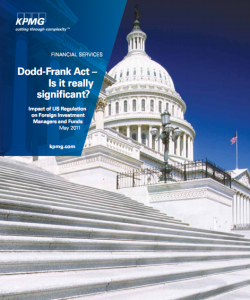A l’apogée de la crise financière, le Gouvernement américain mettait sous toit une réforme législative majeure concernant les marchés et la protection des consommateurs. Comme reporté dans la page très complète de Wikipédia, cette réforme, signée en juillet 2010, devait promouvoir la stabilité financière des Etats-Unis en améliorant l’accountability (la responsabilisation) et la transparence dans le système financier, pour mettre fin au too big to fail, pour protéger le contribuable américain en mettant fin aux sauvetages financiers (ending bailouts), pour protéger le consommateur des pratiques de services financiers abusifs, et pour d’autres objectifs.
Une année après, KPMG a publié une brève analyse qui revient sur les enjeux majeurs de cette réforme :
The far-reaching implications of the Dodd-Frank Act on US financial services organisations, has been widely discussed. Clearly these rules are having a direct impact on US firms, but could also mean big changes for foreign firms. With up to 386 rules required to be enacted by the various regulatory agencies, and the rule making falling behind 2011 targets for completion, firms with any business interest in the US are facing a period of significant change and uncertainty. Foreign funds and investment managers will have to reassess how they run their businesses interests, but ultimately the impact of Dodd-Frank has to be assessed in the wider context of global regulatory initiatives, and the specific rules of each jurisdiction firms operate in.
via Dodd-Frank Act – Is it really significant? Impact of US Regulation on Foreign Investment Managers and Funds May 2011
 The far-reaching implications of the Dodd-Frank Act on US financial services organisations, has been widely discussed. Clearly these rules are having a direct impact on US firms, but could also mean big changes for foreign firms. With up to 386 rules required to be enacted by the various regulatory agencies, and the rule making falling behind 2011 targets for completion, firms with any business interest in the US are facing a period of significant change and uncertainty. Foreign funds and investment managers will have to reassess how they run their businesses interests, but ultimately the impact of Dodd-Frank has to be assessed in the wider context of global regulatory initiatives, and the specific rules of each jurisdiction firms operate in.
The far-reaching implications of the Dodd-Frank Act on US financial services organisations, has been widely discussed. Clearly these rules are having a direct impact on US firms, but could also mean big changes for foreign firms. With up to 386 rules required to be enacted by the various regulatory agencies, and the rule making falling behind 2011 targets for completion, firms with any business interest in the US are facing a period of significant change and uncertainty. Foreign funds and investment managers will have to reassess how they run their businesses interests, but ultimately the impact of Dodd-Frank has to be assessed in the wider context of global regulatory initiatives, and the specific rules of each jurisdiction firms operate in.